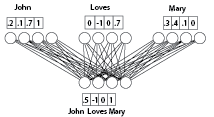The RAAM network
Passive-active transformations can be achieved in part , via a recursive auto-associative memory (RAAM) network (see detailed text).
A RAAM network compresses constituent vectors into complex representations, and decompresses those complex representations back into their constituent parts.
Processes of compression and decompression can be repeated to deal with arbitrarily complex connectionist representations.

John Pollock, 1990.